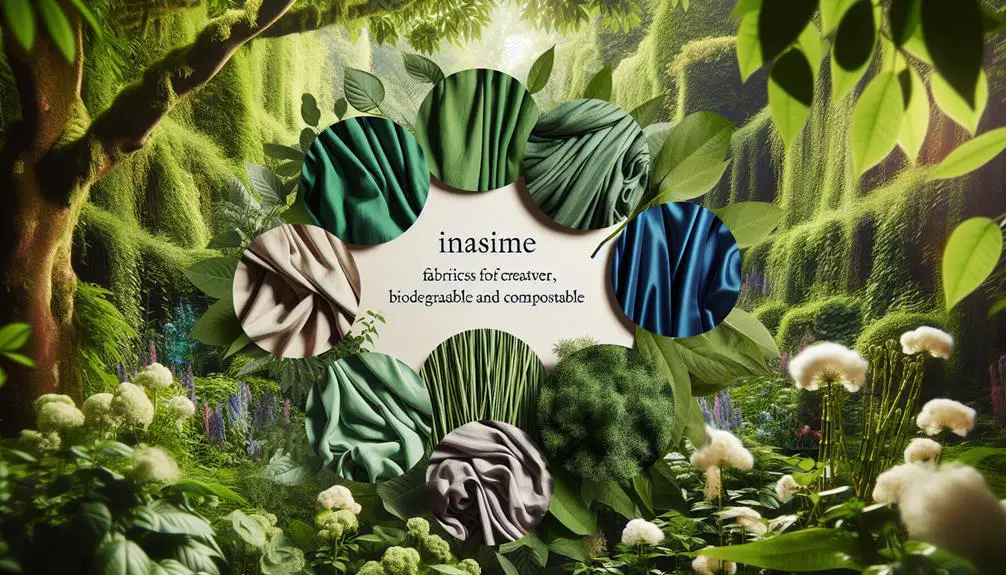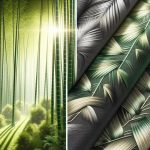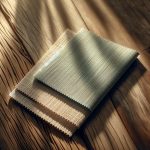When you think about sustainable fashion, the top 10 biodegradable and compostable fabrics should be on your radar. These materials, like organic cotton and hemp, offer more than just eco-friendly credentials; they contribute to soil health and water conservation as well. Imagine wearing clothes that not only look good but also support a greener planet. You might be curious about how fabrics like Tencel, bamboo, and even pineapple fiber fit into this picture. With such a variety of options, understanding their unique benefits and applications can greatly influence your choices. Ready to explore these innovative textiles?
Table of Contents
Key Takeaways
- Organic cotton is grown without synthetic pesticides or fertilizers, supporting soil regeneration and reducing pollution.
- Hemp requires less water and no pesticides, making it a strong, sustainable fabric with a rapid growth cycle.
- Bamboo offers softness and sustainability, growing quickly without pesticides and being breathable and hypoallergenic.
- Tencel (Lyocell) is biodegradable, produced with a closed-loop process that recycles water and solvents.
- Wool is renewable, biodegradable, and supports regenerative agriculture, decomposing efficiently without releasing harmful microplastics.
Organic Cotton
Organic cotton stands out as a top choice for those seeking sustainable and eco-friendly fabrics. Unlike conventional cotton, organic cotton is grown without synthetic pesticides or fertilizers, which not only benefits your health but also supports soil regeneration. By choosing organic cotton, you're encouraging farming practices that restore and maintain soil fertility. These methods lead to healthier ecosystems and more resilient agricultural systems.
When it comes to organic certification, it guarantees that the cotton you're choosing meets stringent environmental and social criteria. This certification ensures that harmful chemicals are kept out of the production process, reducing pollution and promoting water conservation. Organic cotton farming uses a significantly smaller amount of water compared to conventional methods, making it a more sustainable option for our planet's limited water resources.
Supporting fair trade organic cotton also means you're advocating for ethical labor practices. Fair trade standards ensure that farmers receive fair wages and work under safe conditions. By opting for organic cotton, you're not only making an eco-friendly choice but also contributing to a more equitable global economy. Embrace organic cotton to master sustainable living and make a positive impact on the environment and society.
Hemp
Among biodegradable and compostable fabrics, hemp stands out for its impressive sustainability and durability. You'll find that hemp's natural strength makes it ideal for a variety of applications, from clothing to home textiles. Its fibers aren't only robust but also become softer with each wash, enhancing comfort over time.
Hemp cultivation requires notably less water compared to cotton and thrives without the need for pesticides or herbicides. This makes it a highly eco-friendly option, contributing to a more sustainable textile industry. Plus, hemp's rapid growth cycle enables multiple harvests annually, boosting its efficiency and minimizing land use.
In recent years, hemp clothing trends have surged, driven by a growing consumer demand for sustainable fashion. You'll notice that hemp garments aren't just durable but also naturally resistant to mold and ultraviolet light. This guarantees your clothing lasts longer while maintaining its quality.
The hemp textile industry is expanding, with innovations aimed at improving fabric softness and versatility. As you seek to master sustainable fashion choices, incorporating hemp into your wardrobe offers a blend of resilience and environmental responsibility. Ultimately, hemp's exceptional durability and eco-friendly attributes make it a standout choice in the world of biodegradable fabrics.
Bamboo
Bamboo fabric offers a blend of softness and sustainability that's hard to match. As someone keen on sustainable fashion trends, you'll appreciate how bamboo clothing combines comfort with eco-consciousness. When you choose bamboo textiles, you're not just selecting a fabric; you're making a statement about your commitment to the environment.
One of the key benefits of bamboo textiles is their sustainability. Bamboo grows rapidly without the need for pesticides or fertilizers, making it a renewable resource. Plus, bamboo's natural properties make it biodegradable and compostable, perfectly aligning with your eco-friendly wardrobe essentials. This fabric not only feels good on your skin but also leaves a minimal environmental footprint.
Moreover, bamboo clothing is known for its breathability and moisture-wicking abilities, keeping you cool and comfortable. It's also hypoallergenic, making it an excellent choice for sensitive skin. When you add bamboo clothing to your wardrobe, you're investing in pieces that offer both luxury and longevity.
Tencel (Lyocell)
When you explore Tencel (Lyocell), you'll notice its sustainable production process, which uses less water and energy compared to traditional fabrics.
This eco-friendly fabric also boasts benefits like biodegradability and breathability, making it a great choice for conscious consumers.
Sustainable Production Process
Tencel, also known as Lyocell, stands out for its sustainable production process that reduces environmental impact. You'll find that Tencel's journey from raw material to fabric is a model of eco-friendly manufacturing. The process begins with ethically sourced wood pulp, primarily from eucalyptus, beech, and spruce trees. These sources adhere to fair trade practices, guaranteeing that the materials are harvested in a way that supports both the environment and the communities involved.
One of the most striking aspects of Tencel's production is its closed-loop process. This innovative system recycles water and solvents with a recovery rate of more than 99%, greatly reducing its carbon footprint. By using non-toxic solvents, Tencel minimizes pollution and conserves resources, making it a top choice for eco-conscious consumers. The low energy consumption and reduced emissions further highlight its commitment to sustainable production.
Additionally, Tencel's production facilities often seek out renewable energy sources, enhancing its eco-friendly profile. This all-encompassing approach to sustainability ensures that when you choose Tencel, you're supporting a fabric that aligns with high ethical standards and environmental responsibility, making it an excellent option for a greener wardrobe.
Eco-friendly Fabric Benefits
You'll love the myriad benefits that eco-friendly fabrics like Tencel (Lyocell) bring to both you and the environment. Tencel, derived from sustainably sourced wood pulp, reduces the environmental impact compared to traditional fabrics. This eco-friendly fabric stands out in the world of green fashion due to its closed-loop production process, which recycles water and solvents, aligning perfectly with modern recycling initiatives.
Choosing Tencel means you're committing to sustainable consumption. Its biodegradability ensures that, at the end of its life cycle, it won't linger in landfills for centuries. Instead, it decomposes naturally, returning nutrients to the earth. This fabric also boasts impressive durability and breathability, making it a practical choice for everyday wear while maintaining a luxurious feel.
Moreover, Tencel's ability to blend seamlessly with other materials means you can enjoy its benefits across a variety of garments, from casual wear to high-end fashion. By opting for Tencel, you're not just investing in quality; you're supporting a textile that champions environmental stewardship.
Embrace Tencel and be a part of the movement towards a more sustainable, eco-conscious wardrobe.
Jute
As a versatile and environmentally friendly material, jute stands out due to its biodegradability and compostability. When considering jute cultivation, you're looking at a crop that thrives with minimal use of pesticides and fertilizers, making it an eco-conscious choice. Its rapid growth cycle and ability to enhance soil fertility further amplify its environmental benefits. By choosing jute, you're not only opting for sustainability but also contributing to a healthier planet.
In terms of jute textile applications, you'll find that this fabric is incredibly durable, resistant to wear and tear, and versatile enough to be used in a variety of products. From sturdy shopping bags to rustic home decorations, jute has proven its worth in countless practical uses. Its durability characteristics guarantee that items made from jute last longer, reducing the need for frequent replacements.
Here's a glimpse of how jute can make a difference:
| Aspect | Emotional Impact |
|---|---|
| Rapid Growth | Hope for the Future |
| Minimal Pesticide Use | Cleaner Environment |
| Soil Fertility Improvement | Healthier Ecosystems |
| Versatile Applications | Endless Possibilities |
| Durability | Long-lasting Value |
Linen
Linen, renowned for its breathability and strength, is another eco-friendly fabric that offers numerous benefits for sustainable fashion. You'll appreciate that linen cultivation involves fewer pesticides and less water compared to cotton. This not only conserves essential resources but also reduces harmful chemical runoff, making linen an excellent choice for environmentally conscious individuals.
This not only conserves essential resources but also reduces harmful chemical runoff, making linen an excellent choice for environmentally conscious individuals.
When it comes to the dyeing process, linen fabric's natural fibers absorb dyes readily, resulting in vibrant hues with fewer chemicals. This means less environmental impact and a safer garment for you to wear.
Plus, linen's natural color is a chic, earthy tone, often eliminating the need for any dyeing at all.
What makes linen truly exceptional is its durability and breathability. Linen garments are known to be incredibly strong, outlasting many other fabrics. They resist wear and tear, ensuring that your investment in sustainable fashion will stand the test of time.
Additionally, linen's breathability makes it perfect for warm climates, keeping you cool and comfortable.
Soy Silk
You'll find Soy Silk fascinating as it's produced from the byproducts of soybean processing, making it an eco-friendly option.
This fabric not only feels luxurious but also boasts a minimal environmental impact.
Let's explore how its production and source contribute to sustainability and why it's a great choice for biodegradable and compostable fabrics.
Production and Source
Soy silk, derived from the byproducts of soybean processing, offers a sustainable alternative to traditional silk. Its fabric origins lie in the soybean industry, where waste products are cleverly repurposed to create a luxurious, eco-friendly textile. This practice not only maximizes resource use but also delivers significant environmental benefits by reducing waste and minimizing reliance on conventional silk production, which often involves silkworm farming and extensive resource consumption.
When it comes to material sourcing, soy silk exemplifies sustainable practices. The process starts with the extraction of soybean protein, a byproduct that would otherwise be discarded. This protein undergoes a series of steps, including fiber formation and spinning, to transform it into a soft, lustrous fabric. By utilizing existing agricultural waste, soy silk minimizes the environmental footprint associated with raw material extraction, making it a truly sustainable choice.
Moreover, the production of soy silk involves fewer chemicals and less water compared to traditional silk production. This careful approach ensures that the fabric remains biodegradable and compostable, aligning perfectly with eco-friendly principles.
Environmental Impact
By choosing soy silk, you're reducing your environmental footprint due to its minimal chemical use and water consumption. This fabric, derived from soybean hulls, requires less energy and fewer resources compared to traditional textiles, making it a stellar option for sustainable fashion enthusiasts.
Soy silk's production process aligns with recycling initiatives, transforming a by-product of the food industry into a valuable, eco-friendly material. Your commitment to soy silk supports waste reduction and elevates your environmental responsibility.
Unlike conventional fabrics that rely heavily on toxic dyes and extensive water usage, soy silk's natural properties enable a more conscious approach to manufacturing. Its biodegradability guarantees that, at the end of its lifecycle, it won't linger in landfills or pollute ecosystems.
In the world of sustainable fashion, soy silk stands out as a tribute to innovation and eco-conscious design. You're not just wearing a garment; you're making a statement about the kind of world you want to live in.
Incorporating soy silk into your wardrobe is a powerful step towards promoting recycling initiatives and embracing a more sustainable lifestyle. Your choices today shape a cleaner, greener future for generations to come.
Pineapple Fiber (Piñatex)
Piñatex is a revolutionary fabric made from pineapple leaf fibers, offering a sustainable alternative to traditional textiles. You're likely aware that the fashion industry is one of the biggest contributors to environmental degradation. However, by incorporating pineapple fibers into your wardrobe, you can make a significant impact on sustainable fashion. Piñatex isn't only incredibly versatile but also biodegradable, ensuring that your fashion choices don't harm the planet.
When you choose Piñatex, you're opting for eco-friendly accessories that don't compromise on style or durability. This innovative material is derived from the by-products of pineapple harvesting, making it an excellent example of upcycling. By utilizing waste that would otherwise be discarded, Piñatex reduces both agricultural waste and the need for additional resources in fabric production.
Incorporating Piñatex into your wardrobe means you're aligning with a future-focused, eco-conscious movement. From shoes and bags to jackets and upholstery, the applications of this fabric are wide-ranging.
Wool
When you think about wool, consider its natural insulating properties that keep you warm in winter and cool in summer.
Sustainable farming practices guarantee that wool is both eco-friendly and animal-friendly.
Plus, wool is fully biodegradable, breaking down naturally without harming the environment.
Natural Insulating Properties
Wool stands out for its natural ability to provide excellent insulation, keeping you warm in winter and cool in summer. This unique capability arises from wool's inherent thermal regulation properties. The natural fibers in wool trap air, creating an insulating layer that adapts to your body's temperature needs.
Unlike synthetic fabrics, wool maintains its insulating properties even when wet, making it an ideal choice for various weather conditions.
You'll appreciate wool's eco-friendly features, too. As a renewable resource, wool offers sustainable insulation without compromising environmental integrity. The natural fibers are biodegradable and compostable, ensuring they won't contribute to landfill waste. This makes wool a stellar option for those committed to reducing their ecological footprint.
When you choose wool, you're investing in a fabric with an exceptional balance of comfort and sustainability. Its superior insulating properties mean less energy required for heating and cooling, further contributing to a greener lifestyle.
Sustainable Farming Practices
Farmers worldwide are adopting sustainable farming practices to guarantee wool production remains environmentally friendly. You'll find that regenerative agriculture plays a pivotal role in this movement. By focusing on soil health, farmers can enhance biodiversity, improve water retention, and reduce the need for chemical fertilizers. This not only benefits the land but also safeguards the wool produced is of the highest quality.
Ethical sourcing is another critical aspect of sustainable wool production. Farmers prioritize animal welfare, ensuring that sheep are treated humanely throughout their lives. This commitment to ethical practices assures that the wool you purchase doesn't come at the expense of animal well-being.
Circular economy principles are also essential in sustainable wool farming. By recycling and reusing resources within the farming system, waste is minimized and efficiency is maximized. This approach helps create a closed-loop system where the by-products of wool production can be repurposed, enhancing overall sustainability.
When you support wool sourced from farms that prioritize these sustainable practices, you're contributing to a healthier planet. You're endorsing methods that not only produce superior wool but also safeguard and enrich the environment for future generations.
Biodegradability and Decomposition
One of the remarkable features of wool is its natural ability to biodegrade and decompose, contributing to a more sustainable environment. When you choose wool, you're opting for a fabric that breaks down naturally, returning important nutrients to the soil. The biodegradability advantages of wool come from its protein-based structure, which microorganisms can easily digest. This efficient decomposition process guarantees that wool doesn't linger in landfills for centuries like synthetic fabrics.
Understanding the environmental impact of materials is vital for sustainable practices. Wool, when disposed of correctly, decomposes within a few months to a couple of years, depending on environmental conditions. This rapid breakdown not only reduces waste but also minimizes the release of harmful microplastics into ecosystems. By embracing wool, you actively support a cycle that harmonizes with nature rather than working against it.
Moreover, wool's natural properties mean it requires fewer chemical treatments during production, further reducing its environmental footprint. By incorporating wool into your wardrobe or home, you're making a conscious choice that aligns with sustainable practices. You're not just wearing a fabric; you're participating in a movement towards a more eco-friendly future.
Silk
Silk is a lavish, biodegradable fabric created by silkworms, providing a sustainable choice for eco-conscious consumers. If you're contemplating silk substitutes, it's crucial to acknowledge that not all options measure up to silk's sophistication and biodegradability.
Ethical sourcing is pivotal when selecting silk. Traditional silk production can involve practices that harm both the environment and the silkworms. Search for brands that prioritize humane treatment of silkworms and utilize eco-friendly methods, such as organic sericulture.
Silk production has an environmental impact that you should be mindful of. While silk itself is biodegradable, the standard process can be resource-intensive. For example, it necessitates vast amounts of water and energy. Additionally, the chemicals used in some silk dyeing processes can contaminate waterways.
To address these concerns, choose organically produced silk, which reduces chemical use and promotes sustainable farming practices.
Frequently Asked Questions
How Do I Properly Care for Biodegradable Fabrics to Extend Their Lifespan?
To care for biodegradable fabrics, follow these washing tips: use cold water and mild detergent. Practice repair techniques for minor damages. Use proper storage methods like cool, dry places. Embrace sustainable practices to extend their lifespan.
Are Biodegradable Fabrics Suitable for All Types of Weather Conditions?
Biodegradable fabrics excel in winter durability and summer breathability. They offer rainy day resilience and sunny day comfort. While generally suitable for all seasons, their performance varies; choose wisely for extreme conditions to guarantee mastery over your wardrobe.
What Are the Cost Differences Between Biodegradable Fabrics and Synthetic Fabrics?
When comparing costs, biodegradable fabrics might be pricier than synthetic ones, but they offer lower environmental impact. You'll find that affordability varies, yet their performance and durability often justify the investment for eco-conscious consumers.
How Can I Identify if a Fabric Is Truly Compostable?
To identify if a fabric is truly compostable, you should check for fabric certifications and guidelines, and conduct compostable fabric testing. Look for labels like GOTS or TUV Austria, which guarantee strict environmental standards and reliability.
Are There Any Certifications to Look for When Purchasing Biodegradable Fabrics?
Yes, you should look for certifications like GOTS or OEKO-TEX. These certifications guarantee rigorous fabric testing, meet sustainability standards, and adhere to specific certification criteria, reducing the environmental impact of your purchase.
- Are Adidas Gore-Tex Shoes Waterproof? - July 2, 2025
- Is Gore-Tex Waterproof Forever? The Truth About Durability - July 2, 2025
- What Is the Gore-Tex Waterproof Rating in Mm? - July 2, 2025







